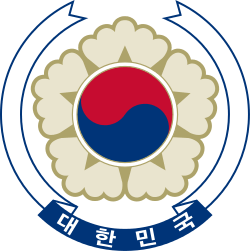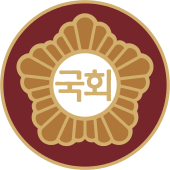Korea Independence Party
Korea Independence Party 한국국민당 韓國國民黨 | |
|---|---|
| Founded | 1928, in Shanghai, Republic of China |
| Dissolved | 1970 |
| Headquarters |
Shanghai, Republic of China (1928-1945) Seoul, South Korea (from 1945) |
| Ideology |
Korean nationalism National conservatism |
| Political position | Right-wing |
 |
| This article is part of a series on the politics and government of South Korea |
| Constitution |

|
|
Judiciary 
|
| Korea Independence Party | |
| Hangul | 한국독립당 |
|---|---|
| Hanja | 韓國獨立黨 |
| Revised Romanization | Han-guk Doglibdang |
| McCune–Reischauer | Han'guk Doklipdang |
The Korea Independence Party (Korean: 한국독립당, Hanguk Doglib Dang, KIP) was a political party in South Korea.
History
The party was established in Shanghai by Kim Koo in 1928, uniting a faction of conservative members of the Provisional Government of the Republic of Korea headed by Kim.[1] When Kim was able to return to Korea in 1945, the KIP began operating in the country. Kim was initially supportive of Syngman Rhee, but a dispute over holding separate elections in South Korea (Kim was opposed, Rhee was for) led to a split and the party did not participate in the 1948 parliamentary elections in South Korea. However, Kim was a candidate in the indirect presidential elections in July 1948, losing heavily to Rhee.
When Kim was assassinated in 1949, the party went into a sharp decline. It participated in the 1950 parliamentary elections, but received only 0.3% of the vote, failing to win a seat. It received the same vote share in the 1960 elections, again failing to win a seat. It nominated Chun Jin-han as its candidate for the May 1967 presidential elections; he finished fifth in a field of six candidates with 2.1% of the vote. Despite increasing its vote share to 2.2% in the June 1967 parliamentary elections, the party remained seatless.
References
- ↑ Haruhiro Fukui (1985) Political parties of Asia and the Pacific, Greenwood Press, p671
